Fully charged
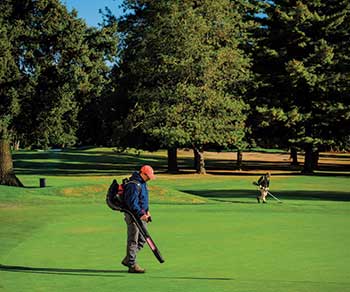
Updated battery-powered backpack blowers keep the noise level down on golf courses, allowing crews to get more done in the early morning hours and during play. (Photo: Steve Cherry)
According to California Air Resources Board (CARB) stats released in July, the number of small off-road engines in California, which includes engines in golf course maintenance equipment, is greater than the number of light-duty passenger cars — 16.7 million to 13.7 million.
Here’s another brain-busting CARB stat: One hour of operating the best-selling commercial leaf blower yields smog-forming pollution comparable to driving a 2017 Toyota Camry 1,100 miles — approximately the distance from Los Angeles to Denver.
That’s right, that’s 1,100 miles of emissions in one hour of operation.
What’s the environmentally conscious superintendent to do?
Lithium ion battery-powered equipment could be a potential answer. These tools are lighter, are becoming increasingly powerful, and lithium ion batteries have helped the green industry go from low-voltage tools to high-powered gas replacement tools.
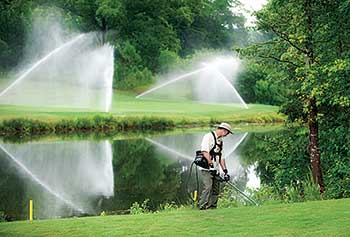
Battery-powered handheld edgers and trimmers have the option to be connected to backpack battery units, extending runtime. (Photo: Greenworks Commercial)
Driving the growth of cordless power equipment are noise and emissions restrictions on gas-powered small engines. According to Greenworks’ aggregated research, in October 2017, 250 cities in the United States had noise regulations, and that number has shot up to 500 cities today. With quieter (around 57 decibels compared to 75 decibels) zero-emissions tools, crews can work an additional three to six hours a day — hours that previously were lost because of noise and pollution ordinances.
Runtime is typically a concern, but many of these tools have 4 to 5 hours or more of life in them with a full charge. Depending on the tool and manufacturer, batteries can be fully charged in 37 to 90 minutes. Larger backpack batteries might take 3 to 5 hours to charge, but superintendents are finding that being diligent about charging batteries, planning ahead and having backup batteries for longer jobs will give them enough juice to get through the day.
Paul Spengler, executive director at Pebble Beach Golf Links, has been a fan of battery-powered tools since he first met with the Greenworks team at the company’s offices in Mooresville, N.C.
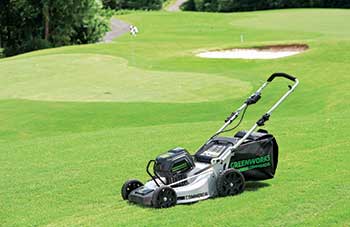
Greenworks Commercial’s 82V batteries are interchangeable between handheld tools and push mowers. (Photo: Greenworks Commercial)
After the two-hour meeting and demo, he said his first question was, “Do you guys want to get into the golf market?” Up to that point, the company primarily focused on landscaping.
“It was my ‘a-ha’ moment,” Spengler says. He immediately recommended the equipment to Chris Dalhamer, CGCS, Pebble Beach, as well as Manny Fernandez, the head of landscaping for the property.
“These different noise restrictions that country clubs, HOAs and resorts are going through, this is the ideal solution for all of that,” Spengler explains. “The whole point of this quieter equipment is to provide a better experience for the people around it.”
Battery power on the big stage
How does the equipment fare in major tournament play, when all eyes (and ears) are on the golf course?
Paul Vermeulen, vice president of championship agronomy for the PGA Tour, saw for himself when Greenworks partnered with the 2017 Presidents Cup, played at Liberty National Golf Course in Jersey City, N.J.
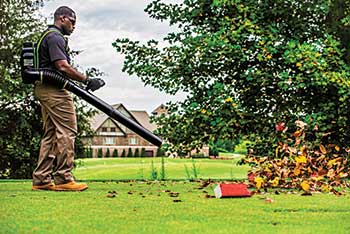
Less vibration, a push-button start and minimal maintenance
are among the upsides for operators of battery-powered tools. (Photo: Greenworks Commercial)
The company had equipped four members of the maintenance staff with the backpack blowers. The crew proceeded to blow off greens two holes ahead of the tournament’s lead players without causing a disturbance.
“There is something unique about the week we host a tournament — we have a large audience on the property,” says Vermeulen. “The electric blowers are a good fit for our tournament week operations.”
Vermeulen notices a significant increase in airflow and airspeed with the new generation of battery-powered backpack blowers compared with their earlier counterparts. “It’s not something that you have to actually measure in order to make product comparisons,” he says. “I don’t need to measure anything, I know that this one has more power.”
The Presidents Cup wasn’t the only big tournament where battery power was in the spotlight. During this year’s American Century Championship tournament at Edgewood Tahoe Golf Course, Greenworks got a shout-out on NBC Sports when superintendent Brad Wunderlich was shown on camera blowing off a green with one of the company’s backpack blowers.
Taking down trees at TPC Boston
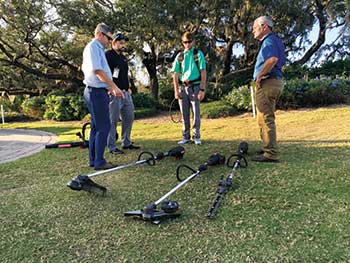
Superintendents demo Oregon’s 120-volt hedge trimmer, edger, string trimmer and backpack blower at the 2017 Golfdom Summit. (Photo: Seth Jones)
For the superintendent of TPC Boston, Tom Brodeur, the typical wear and tear and operator issues — periodic leaks and dripping, and the equipment getting overfilled with gas — have been a concern as his handheld equipment has aged.
The TPC Boston team has found that battery-powered tools have cut back on the need for mixing and transporting fuel around the golf course. The lack of a 2- or 4-cycle motor in handheld equipment has eliminated the necessity of oil and maintenance problems such as fuel leaks on turf.
Brodeur is happy with his current lineup of battery-powered equipment — a Greenworks chainsaw, pole saw and handheld and backpack blowers. Which is a good thing, since TPC Boston’s location with thousands of trees can quickly become maintenance heavy. “Plants are constantly growing in on us, and we’re constantly having to limb them up,” Brodeur explains.
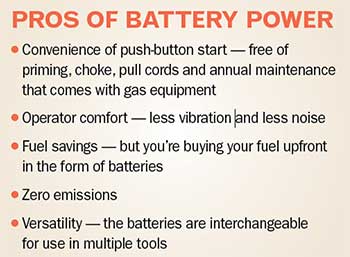
Graphic: Golfdom staff
In March of this year, four big storms rolled in with high winds and caused the course to lose a lot of plant material, including several 70- and 80-foot white pines. The TPC Boston crew fired up a Greenworks 18-inch electric chainsaw for that job, and found that it stood up to the test.
“It’s every bit as powerful as a gas chainsaw of similar size,” Brodeur says. “I can’t think of a piece of 4-stroke equipment that is more testy when it comes to the engine than a chainsaw. Just having that, where you can just put the battery in, undo the safety, and press a button and go — it works just fine with most everything we do.”
Even though the technology is becoming more efficient, some people still
prefer gas. “I’m noticing it’s hard to get the guys to switch,” Brodeur says. “Some of them like the gas because it’s more powerful, but the one they have right now is pretty good for the electric backpack blower.”
And there are some things that a battery-powered blower isn’t equipped to handle, such as heavy leaf cleanup or blowing off greens from aeration — those tasks still are firmly in the hands of gas-powered tools, says Brodeur.
Still, he believes there’s a place for these handhelds in the shop. “I’m not saying I have endless amounts of money and I want to be wasteful, but (battery-powered tools) make the operation better in a number of ways that do have economic value, and they certainly have quality-of-operation value,” Brodeur says.
Waste not, want not

Handhelds can handle cleanups on greens and cart paths, but experts say that gas power is still the go-to for heavy-duty jobs. (Photo: Greenworks Commercial)
Larry Raschko, superintendent of Willamette Valley Country Club, in Canby, Ore., heard about Oregon Outdoor Power Equipment’s battery-powered handhelds from a club member who worked in the blade division at the company. He started out with a 40-volt chainsaw, a weed eater and portable work lights.
Longevity and power were a concern with the 40-volt equipment. Not wanting to waste the tools once they were purchased, his crew found little niche tasks that the tools could accomplish, such as cleaning sprinkler heads and valve boxes. “Once you cut the string really short, it cleans out a sprinkler head just beautifully,” advises Raschko. “Otherwise, you have to do it with a shovel, so it’s saved us a lot of
time.”
Willamette Valley CC is surrounded by massive fir trees, and Raschko has found that even the 40-volt chainsaw made quick work of fallen tree limbs. “It’s lightweight, you grab it and you go and you’re done, rather than having to grab the gas, check it for oil, put gas in it and all that.”
Raschko recently received a demonstration of Oregon’s 120v battery-powered tools, which include a backpack blower, a string trimmer, a hedge trimmer and an edger — and found that the previous runtime and battery issues were solved.
He’s impressed with the runtime and power of the edger in particular. “You’ll run into some hard-pan soil, and it’ll stop the blade on a belt-driven gas-powered edger,” he says. “As far as using the 120-volt edger for five, six hours, it’ll power right through hard-pan soil.”
Even in this early stage of using the latest Oregon tools, Raschko is on board. “My budget for this year is pretty much set, but as our gas tools begin to get used up, we’ll be looking at buying this new generation of (Oregon) tools to replace it,” he says.
Buzzworthy battery power
Like many others in the industry, the backpack blower was the first piece of equipment that caught John Patterson’s eye.
Patterson, equipment director at Atlanta Athletic Club (AAC), says, “We thought (the blowers) would be the biggest impact for our members and get some buzz going around the clubhouse and let people know we’re moving that way.”
Director of Agronomy Lukus Harvey was open to taking a look at new equipment, but Patterson led the charge when it came to switching to battery power. AAC now has two backpack blowers, two batteries and two chargers.
“It’s good for our membership,” says Patterson. “One of our clubhouse guys was able to be right up close to where their members were meeting, and no heads raised. That means a lot to us, it adds up to a better member experience.”
Patterson considers himself a big proponent of the environment. During his years at Doral Golf Resort in Miami, he looked for ways to convert cooking oil to biodiesel for equipment on the golf course, he uses battery-powered equipment at home and also has a lithium-powered bike.
“I think even if you don’t come into this business as an environmentalist, you become one,” he says.
Patterson is measured when he discusses how effective the battery-powered tools are. Though he says the Oregon blower doesn’t match the Stihl BR600 as far as blowing debris out of bunkers, on short grass and areas around cart paths, they handle the work just fine.
AAC is looking to purchase stick edgers next, and they plan to plug certain pieces into their equipment arsenal that will provide the most bang for their buck, as far as member experience and productivity.
The improvements in battery-powered tech have been a gateway to a larger goal for AAC. Patterson has begun to look at solar panels and commissioning a study to find out how many kilowatts they can get out of their rooftops at the golf course maintenance facility.
“Ideally, what Lukus and I would like to see is the rooftops here covered in solar panels with Tesla walls, lithium storage banks, all of our lightweight utility vehicles, all of our walk mowers and our triplex mowers being lithium powered,” he says. He hopes that will happen in the next five years, but he admits that might be a little optimistic.
In the meantime, he’s making small steps toward making his handheld arsenal all battery powered. Right now, he thinks that battery-powered tools have made great strides and are useful for golf courses looking to cut back on their environmental footprint, but there’s still room to improve.
“I don’t think they’re the end-all, do-all,” he says. “But what they’re doing, they’re doing really well.”











